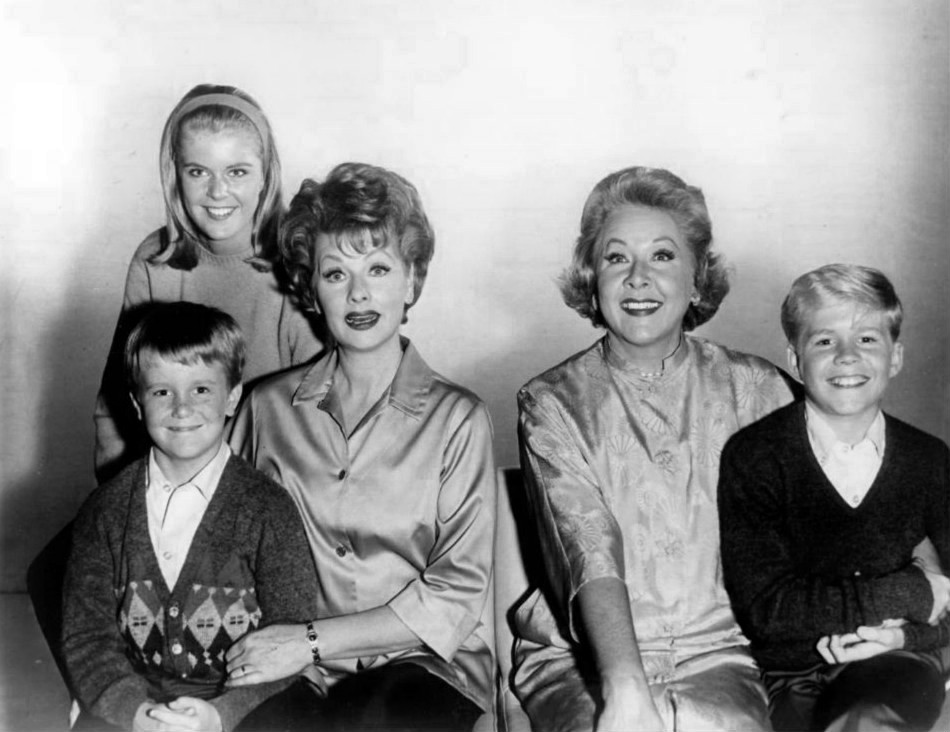Television’s Early Divorcées
April 25, 2019

After Lucille Ball and Desi Arnaz divorced, Lucy became a widow on “The Lucy Show” and the former “Ethel” became the divorced “Viv,” complete with the more stylish hairdos and clothes the divorced actress Vivian Vance demanded.
PAUL MICHAEL CLARK writes:
Given your post about The Brady Bunch and prime-time propaganda, you might find interesting the following extract from Barry Williams’s memoir Growing Up Brady. Mr. Williams, who played the eldest son on that show, here recalls a pre-production meeting between Brady Bunch creator Sherwood Schwartz and ABC bosses regarding Carol Brady, the mother character:
“Sherwood and the network locked horns over the fate of Carol’s first husband. Sherwood wanted him alive, well, and happily divorced from Carol, but the network demanded his death. Sherwood met with the brass, smiled, nodded, and was extremely polite, but paid no attention to the suggestions: he left the fate of the girls’ father uncertain. You may notice she never refers to the guy as being dead. In Sherwood’s mind, Carol Brady was television’s first divorcee!”
As an unwitting chronicler of social decline, however, Barry Williams displays a curious ignorance about his era’s TV history, odd for a man whose fame is buried there. Seven years before The Brady Bunch first appeared, actress Vivian Vance made her debut as divorced mother Viv Bagley on CBS’s The Lucy Show. This was no cameo, but rather a multi-season, co-star role as sidekick to Lucille Ball’s title character. In addition, a couple of years after Miss Vance left the program, she reprised “Viv” for guest appearances in which the character was by then “remarried.” (Off screen, Vivian Vance was on her fourth “marriage” while Lucille Ball had recently divorced Desi Arnaz. To locate The Lucy Show in our cultural timeline, it premiered the same month as did Vatican II.)
The Lucy Show was based on Life Without George, journalist Irene Kampen’s 1961 book about her own post-divorce life. This is Kirkus Reviews on the source material provided by Mrs. Kampen:
“A feminine audit of a life without a man provides an intimate to dégagé rundown of its pleasures (neglecting the dishes; putting on blue nail polish; reading old Kathleen Norris novels) as against the difficulties (the blown fuse; stalled car; and – obviously – the checkbook). It also provides some scattered vignettes of two not always gay divorcees and their householding in Connecticut (near Danbury) with a child apiece and two Siamese cats. There are the occasional men who prefer to settle in for a comfortable evening rather than take them out; the winters of snow shoveling and commuting; the coping with the encroachment of sumac on the lawn or water in the cellar. On the other hand, there’s Harry, and his casual camaraderie; some hostessing at a horse show; and their dedicated participation in the little theater group and a soggy production of Rain.”
I admit I had trouble following some of that (being married excludes novels by Kathleen Norris how?) but then I haven’t read Life Without George. Anyway, the book’s TV descendant refashioned Irene/Lucy as a widow, just as ABC’s overseers imagined they’d done with Carol Brady. But Viv Bagley was no stealth divorcée like Carol. The Lucy Show’s writers freely launched jokes about Viv’s divorced status.
It’s unclear why Brady Bunch overlords imagined the mass audience of 1969 would reject a positive portrayal of divorce and “remarriage.” As a social marker, The Brady Bunch appeared more than two decades after the “family” classic Miracle on 34th Street successfully defied that quaint species of complaint. The Lucy Show consistently roosted in the top 10 of the Nielsen ratings throughout its life.
Despite their self-flattery, TV producers in the late 1960s and beyond didn’t corrupt their audiences. TV producers served already corrupt audiences what they wanted. Only three years after The Brady Bunch premiered, CBS’s Maude offered a twice-divorced title character who lived with her incumbent “husband” and divorced daughter. About midway between the show’s first episode and the Roe v. Wade decision, Maude famously underwent a legal New York abortion. America vented its outrage by making Maude a Nielsen Top 10 fixture for most of its run.
By the way, Mary Richards in The Mary Tyler Moore Show was originally supposed to be a divorcée. Her status changed, but not because network supervisors feared negative attitudes about divorce. Miss Moore had first found fame playing Laura Petrie, the wife on The Dick Van Dyke Show, and CBS executives – never quick to overestimate audience intelligence – worried that viewers might assume her new character had divorced Rob Petrie. The Mary Tyler Moore Show soon enough introduced sympathetic divorces for feature characters, while assuring viewers that Mary Richards might be single but did not neglect to take her Pill.
Laura writes:
Thank you for that bit of television history. To complain about the glamorization of divorce on television is indeed quaint, sort of like driving a horse and buggy or wearing suspenders.
You can read about the 1964 Supreme Court ruling and its influence on Federal Communications Commission’s regulation of content on TV here. Before that, television shows were not even permitted to show double beds in the bedrooms of married couples or use the word “pregnancy.” The idea now is that indecency should be determined by the viewing audience, not by any authority.
